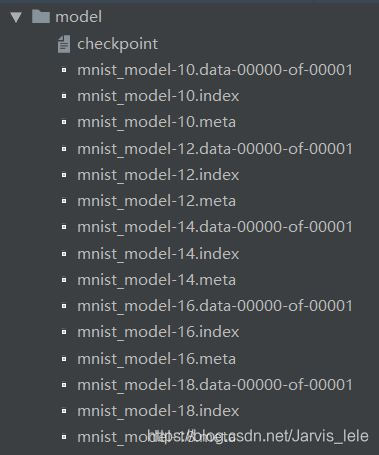绪论
在训练神经网络模型的时候,当模型训练完之后,确切地说当训练的session关闭之后,我们训练出来的模型参数会全部丢失,从而无法有效复用模型,而TensorFlow中提供了很好地保存模型和提取模型的方法。
目录
1. Tensorflow的模型到底是什么样的?
Tensorflow模型主要包含网络的设计(图)和训练好的各参数的值等。所以,Tensorflow模型有四个文件:
① checkpoint 文件会记录保存信息,通过它可以定位最新保存的模型
② model.ckpt.data-xxx 文件保存了当前参数值
③ model.ckpt.index 文件保存了当前参数名
④ model.ckpt.meta 文件保存了Tensorflow图;即所有的变量、操作、集合等
2. Tensorflow模型的保存
① 首先,为了保存Tensorflow中的图和所有参数的值,我们创建一个tf.train.Saver()类的实例。
saver = tf.train.Saver()
② 由于Tensorflow变量仅存在于session内,所以必须在session内进行保存,可通过调用创建的saver对象的save方法实现。
saver.save(sess, path+"model_conv/my-model", global_step=epoch)
其中:
- sess是session对象。
- path+"model_conv/my-model"是你对自己模型的路径+命名。
- global_step表示迭代多少次就保存模型(比如每迭代1000次后保存模型:global_step=1000),一般使用全局步数global_step,这样才能够实现断点继训。
- 如果你想保存最近的4个模型并且每训练两个小时保存一次,可以使用 max_to_keep=4 和 keep_checkpoint_every_n_hours=2。
- Tensorflow中默认保存最近的5个模型。
③ 我们在tf.train.Saver()中并没有指定任何东西,因此它将保存所有变量。如果我们不想保存所有的变量,只想保存其中一些变量,我们可以在创建tf.train.Saver实例的时候,给它传递一个我们想要保存的变量的list或者字典。示例如下:
import tensorflow as tf
w1 = tf.Variable(tf.random_normal(shape=[2]), name='w1')
w2 = tf.Variable(tf.random_normal(shape=[5]), name='w2')
saver = tf.train.Saver([w1,w2])
sess = tf.Session()
sess.run(tf.global_variables_initializer())
saver.save(sess, 'my_test_model',global_step=1000)
实例代码:
import tensorflow as tf
#Prepare to feed input, i.e. feed_dict and placeholders
w1 = tf.placeholder("float", name="w1")
w2 = tf.placeholder("float", name="w2")
b1= tf.Variable(2.0,name="bias")
#Define a test operation that we will restore
w3 = tf.add(w1,w2)
w4 = tf.multiply(w3,b1,name="op_to_restore")
with tf.Session() as sess:
sess.run(tf.global_variables_initializer())
#Create a saver object which will save all the variables
saver = tf.train.Saver()
#Run the operation by feeding input
print(sess.run(w4,feed_dict ={w1:4,w2:8}))
#Prints 24 which is sum of (w1+w2)*b1
#Now, save the graph
saver.save(sess, './my_test_model',global_step=1000)
3.Tensorflow模型的加载
如果要使用已经训练好的模型,那么你需要做两个步骤:
① 创建网络Create the network:
你可以通过写python代码,来手动地创建每一个、每一层,使得跟原始网络一样。
但是,如果你仔细想的话,我们已经将模型保存在了 .meta 文件中,因此我们可以使用tf.train.import()函数来重新创建网络,使用方法如下:
saver = tf.train.import_meta_graph('./my_test_model-1000.meta')
注意,这仅仅是将已经定义的网络导入到当前的graph中,但是我们还是需要加载网络的参数值。
② 加载参数Load the parameters
我们可以通过调用restore函数来恢复网络的参数,如下:
with tf.Session() as sess:
new_saver = tf.train.import_meta_graph('my_test_model-1000.meta')
new_saver.restore(sess, tf.train.latest_checkpoint('./'))
在这之后,像w1和w2的tensor的值已经被恢复,并且可以获取到:
with tf.Session() as sess:
saver = tf.train.import_meta_graph('my-model-1000.meta')
saver.restore(sess,tf.train.latest_checkpoint('./'))
print(sess.run('w1:0'))
##Model has been restored. Above statement will print the saved value of w1.
实例代码:
上面介绍了如何保存和恢复一个Tensorflow模型。下面介绍一个加载任何预训练模型的实用方法。
现在,我们想要恢复这个网络,我们不仅需要恢复图(graph)和权重,而且也需要准备一个新的
feed_dict,将新的训练数据喂给网络。
- 我们可以通过使用graph.get_tensor_by_name()方法来获得已经保存的操作(operations)和placeholder variables。
#How to access saved variable/Tensor/placeholders
graph = tf.get_default_graph()
w1 = graph.get_tensor_by_name("w1:0")
## How to access saved operation
op_to_restore = graph.get_tensor_by_name("op_to_restore:0")
(注:
- 操作的名称为训练模型中name后面的名称
- 如果参数是这样保存的:
with tf.name_scope('conv1'):
W1 = tf.Variable(tf.truncated_normal([784, 500], stddev=0.1), name='W1')
那么调用的时候需注意:
graph = tf.get_default_graph()
w1 = graph.get_tensor_by_name("conv1/w1:0")
- 如果我们仅仅想要用不同的数据运行这个网络,可以简单的使用feed_dict来将新的数据传递给网络。
import tensorflow as tf
with tf.Session() as sess:
#First let's load meta graph and restore weights
saver = tf.train.import_meta_graph('./my_test_model-1000.meta')
saver.restore(sess,tf.train.latest_checkpoint('./'))
# Now, let's access and create placeholders variables and
# create feed-dict to feed new data
graph = tf.get_default_graph()
w1 = graph.get_tensor_by_name("w1:0")
w2 = graph.get_tensor_by_name("w2:0")
#Now, access the op that you want to run.
op_to_restore = graph.get_tensor_by_name("op_to_restore:0")
'''
#Add more to the current graph
add_on_op = tf.multiply(op_to_restore,2)
print sess.run(add_on_op,feed_dict ={w1:13.0,w2:17.0})
#This will print 120.
'''
print (sess.run(op_to_restore,feed_dict ={w1:13.0,w2:17.0}))
4. 如何保存pb文件和读取pb文件
上面模型的保存文件为ckpt文件,有多个文件组成。但很多时候,我们需要将TensorFlow的模型导出为单个文件(同时包含模型结构的定义与权重),方便在其他地方使用(如在Android中部署网络)。
下面的代码展示了最简单的tensorflow四则运算计算图:
import tensorflow as tf
x = tf.placeholder(tf.float32,name="input")
a = tf.Variable(tf.constant(5.,shape=[1]),name="a")
b = tf.Variable(tf.constant(6.,shape=[1]),name="b")
c = tf.Variable(tf.constant(10.,shape=[1]),name="c")
d = tf.Variable(tf.constant(2.,shape=[1]),name="d")
tensor1 = tf.multiply(a,b,"mul")
tensor2 = tf.subtract(tensor1,c,"sub")
tensor3 = tf.div(tensor2,d,"div")
result = tf.add(tensor3,x,"add")
inial = tf.global_variables_initializer()
with tf.Session() as sess:
sess.run(inial)
print(sess.run(a))
print(result)
result = sess.run(result,feed_dict={x:1.0})
print(result)
constant_graph = tf.graph_util.convert_variables_to_constants(sess, sess.graph_def, ["add"])
with tf.gfile.FastGFile("wsj.pb", mode='wb') as f:
f.write(constant_graph.SerializeToString())
- 保存pb文件的功能主要是通过下面三行代码实现的
constant_graph = tf.graph_util.convert_variables_to_constants(sess, sess.graph_def, ["add"])
with tf.gfile.FastGFile("wsj.pb", mode='wb') as f:
f.write(constant_graph.SerializeToString())
第一行代码的作用是将计算图中的变量转化为常量,并指定输出节点为“add”
第二行代码用来生成一个名为wsj.pb的文件(未指定路径的话,默认在该python代码的同路径下生成)
第三行代码的作用是将计算图写入该pb文件中
- 读取pb文件
import tensorflow as tf
with tf.gfile.FastGFile("wsj.pb", "rb") as f:
graph_def = tf.GraphDef()
graph_def.ParseFromString(f.read())
result, x = tf.import_graph_def(graph_def,return_elements=["add:0", "input:0"])
with tf.Session() as sess:
init = tf.global_variables_initializer()
sess.run(init)
print(sess.run(a))
result = sess.run(result, feed_dict={x: 5.0})
print(result)
上面代码主要分为两部分:读取pb文件并设置为默认的计算图;填充一个新的x值来计算结果。
读取pb文件时候需要注意的是,若要获取对应的张量必须用“tensor_name:0”的形式,这是tensorflow默认的。
5. 断点继训
顾名思义,断点续训的意思是因为某些原因模型还没有训练完成就被中断,下一次训练可以在上一次训练的基础上继续训练而不用从头开始;这种方式对于你那些训练时间很长的模型来说非常友好。
如果要进行断点续训,那么得满足两个条件:
(1)本地保存了模型训练中的快照;(即断点数据保存)
(2)可以通过读取快照恢复模型训练的现场环境。(断点数据恢复)
这两个操作都用到了tensorflow中的train.Saver类。
具体代码如下:
ckpt = tf.train.get_checkpoint_state(MODEL_SAVE_PATH)
if ckpt and ckpt.model_checkpoint_path:
saver.restore(sess, ckpt.model_checkpoint_path)
······
saver.save(sess, os.path.join(MODEL_SAVE_PATH, MODEL_NAME), global_step=global_step)
#global_step为全局步数
6. 如何使用预训练好的模型来用于Finetuning
Finetuning的意思是在已有模型之后进行参数和训练模型复用的缩写,也是真实工程应用中最常用的的是由既有模型的手段。
我们可以通过graph.get_tensor_by_name() 方法来获取合适的operation,然后在这上面建立graph。下面是一个实际的例子,我们使用meta graph 加载了一个预训练好的vgg模型,并且在最后一层将输出个数改成2,然后用新的数据Finetuning。
......
......
saver = tf.train.import_meta_graph('vgg.meta')
# Access the graph
graph = tf.get_default_graph()
## Prepare the feed_dict for feeding data for fine-tuning
#Access the appropriate output for fine-tuning
fc7= graph.get_tensor_by_name('fc7:0')
#use this if you only want to change gradients of the last layer
fc7 = tf.stop_gradient(fc7) # It's an identity function
fc7_shape= fc7.get_shape().as_list()
new_outputs=2
weights = tf.Variable(tf.truncated_normal([fc7_shape[3], num_outputs], stddev=0.05))
biases = tf.Variable(tf.constant(0.05, shape=[num_outputs]))
output = tf.matmul(fc7, weights) + biases
pred = tf.nn.softmax(output)
# Now, you run this with fine-tuning data in sess.run()
完整代码
最后,只需要在我们前面所写好的mnist代码中加入上面的语句,即可保存和恢复我们训练好的模型了,完整代码如下:
- MNIST_TRAIN.py
import tensorflow as tf
import os
from tensorflow.examples.tutorials.mnist import input_data
mnist = input_data.read_data_sets("MNIST_data", one_hot=True)
'''
定义固定的超参数,方便待使用时直接传入。如果你问,这个超参数为啥要这样设定,如何选择最优的超参数?
这个问题此处先不讨论,超参数的选择在机器学习建模中最常用的方法就是“交叉验证法”。
另外,还要设置两个路径,第一个是数据下载下来存放的地方,一个是summary输出保存的地方。
'''
MODEL_SAVE_PATH = "model" # 模型保存路径
MODEL_NAME = "mnist_model" # 模型保存文件名
logdir = './graphs/mnist' # 输出日志保存的路径
dropout = 0.6
learning_rate = 0.001
STEP = 30
# 每个批次的大小
batch_size = 100
# 计算一共有多少个批次
n_batch = mnist.train.num_examples // batch_size
x = tf.placeholder(tf.float32, [None, 784], name='x_input')
y = tf.placeholder(tf.float32, [None, 10], name='y_input')
keep_prob = tf.placeholder(tf.float32, name='keep_prob')
lr = tf.Variable(0.001, dtype=tf.float32, name='learning_rate')
global_step = tf.Variable(0, trainable=False)
image_shaped_input = tf.reshape(x, [-1, 28, 28, 1])
W1 = tf.Variable(tf.truncated_normal([784, 500], stddev=0.1), name='W1')
b1 = tf.Variable(tf.zeros([500]) + 0.1, name='b1')
L1 = tf.nn.tanh(tf.matmul(x, W1) + b1, name='L1')
L1_drop = tf.nn.dropout(L1, keep_prob)
W2 = tf.Variable(tf.truncated_normal([500, 300], stddev=0.1), name='W2')
b2 = tf.Variable(tf.zeros([300]) + 0.1, name='b2')
L2 = tf.nn.tanh(tf.matmul(L1_drop, W2) + b2, name='L2')
L2_drop = tf.nn.dropout(L2, keep_prob)
W3 = tf.Variable(tf.truncated_normal([300, 10], stddev=0.1), name='W3')
b3 = tf.Variable(tf.zeros([10]) + 0.1, name='b3')
prediction = tf.matmul(L2_drop, W3) + b3
preValue = tf.argmax(prediction, 1,name='predict')
# 计算所有样本交叉熵损失的均值
loss = tf.reduce_mean(tf.nn.softmax_cross_entropy_with_logits(labels=y, logits=prediction), name='loss')
optimizer = tf.train.AdamOptimizer(lr).minimize(loss, global_step=global_step, name='train')
# 计算准确率
# 分别将预测和真实的标签中取出最大值的索引,若相同则返回1(true),不同则返回0(false)
correct_prediction = tf.equal(tf.argmax(y, 1), tf.argmax(prediction, 1))
# 求均值即为准确率
accuracy = tf.reduce_mean(tf.cast(correct_prediction, tf.float32), name='accuracy')
saver = tf.train.Saver() # 实例化saver对象
with tf.Session() as sess:
# 初始化变量
init = tf.global_variables_initializer()
sess.run(init)
# 断点续训,如果ckpt存在,将ckpt加载到会话中,以防止突然关机所造成的训练白跑
ckpt = tf.train.get_checkpoint_state(MODEL_SAVE_PATH)
if ckpt and ckpt.model_checkpoint_path:
saver.restore(sess, ckpt.model_checkpoint_path)
for i in range(STEP):
for batch in range(n_batch):
batch_xs, batch_ys = mnist.train.next_batch(batch_size)
opt, step = sess.run([optimizer, global_step], feed_dict={x: batch_xs, y: batch_ys, keep_prob: dropout})
acc_train, step = sess.run([accuracy, global_step],
feed_dict={x: mnist.train.images, y: mnist.train.labels, keep_prob: 1.0})
# 记录训练集的summary
acc_test = sess.run([accuracy], feed_dict={x: mnist.test.images, y: mnist.test.labels, keep_prob: 1.0})
if i % 2 == 0:
print("Iter" + str(step) + ", Testing accuracy:" + str(acc_test) + ", Training accuracy:" + str(acc_train))
saver.save(sess, os.path.join(MODEL_SAVE_PATH, MODEL_NAME), global_step=step) # 保存模型
constant_graph = tf.graph_util.convert_variables_to_constants(sess, sess.graph_def, ["predict"])
with tf.gfile.FastGFile("mnist_model.pb", mode='wb') as f:
f.write(constant_graph.SerializeToString())
保存后的模型文件:
- MNIST_TEXT.py
#对输入的真实图片,输出预测结果
#coding:utf-8
import tensorflow as tf
import numpy as np
import cv2 as cv
MODEL_SAVE_PATH="model"#模型保存路径
pb_model_path="mnist_model.pb"
def demo_model(testPicArr):
with tf.gfile.FastGFile(pb_model_path, "rb") as f:
graph_def = tf.GraphDef()
graph_def.ParseFromString(f.read())
x, keep_prob, predict = tf.import_graph_def(graph_def, return_elements=["x_input:0", "keep_prob:0",
"predict:0"])
with tf.Session() as sess:
'''
#读取ckpt文件
saver = tf.train.import_meta_graph(model_dir + ".meta")
saver.restore(sess, model_dir)
graph = tf.get_default_graph()
x = graph.get_tensor_by_name("input/input_x:0")
keep_prob=graph.get_tensor_by_name("input/keep_prob:0")
predict = graph.get_tensor_by_name("predict:0")
'''
index = sess.run(predict, feed_dict={x: testPicArr,keep_prob:1})
return index
def pre_pic():
# 读取图像,支持 bmp、jpg、png、tiff 等常用格式
img = cv.imread('./photo/1.png', 0)
img = cv.resize(img, (28, 28), cv.INTER_AREA)
ret, thresh = cv.threshold(img, 127, 255, cv.THRESH_BINARY_INV) # 反向二值化,将白底黑字变成黑底白字
cv.imshow('image', img)
cv.imshow('thresh', thresh)
im_arr = np.array(thresh) # 将图片格式转化为矩阵
nm_arr = im_arr.reshape([1, 784]) # 化为[1,784]的一维矩阵
nm_arr = nm_arr.astype(np.float32)
img_ready = np.multiply(nm_arr, 1.0 / 255.0) # 将每个像素点变成0-1之间的浮点数
return img_ready,thresh
def application():
demoPicArr,thresh=pre_pic()
preValue=demo_model(demoPicArr)
print('The prediction number is:',preValue)
cv.imshow('thresh', thresh)
cv.waitKey(0)
cv.destroyAllWindows()
def main():
application()
if __name__=='__main__':
main()


